Well, if I figured the half square bend delay correctly in HR, the BWC's response is very similar to Tom's DTS concept THs whereas the TH variant looks more like a 6th order BP response, so the TH has bit more mid band output while the BWC has a bit more LF and HF [shadow is the TH]:
GM
GM
Attachments
Sure Freddi, plywood is fine.
GM (Government Motors) made some cars with the Bose cannon. The massive 4-1/2" driver was in the corner of the trunk, with the short tube running up through the door and exiting up near the driver, the long tube ran across the trunk and through the other door and exited up near the passenger. The tubes were a rough oval, and made of genuine plastic.
The optimum geometry is to have the two pipe exits one-half of the total pipe length apart, the front pipe one-quarter of the total pipe length. It's based on half-square antenna theory, shaped like an inverted 'U'. Being a loudspeaker it can be folded into any convenient shape (as it was in their boom-box).
As for the cannon vs the tapped horn, I don't know. For portability issues having the two pipe ends half the total length may not be a good form factor. I don't know how to sim this Bose design either. Any AkAbak wizzards?
GM (Government Motors) made some cars with the Bose cannon. The massive 4-1/2" driver was in the corner of the trunk, with the short tube running up through the door and exiting up near the driver, the long tube ran across the trunk and through the other door and exited up near the passenger. The tubes were a rough oval, and made of genuine plastic.
The optimum geometry is to have the two pipe exits one-half of the total pipe length apart, the front pipe one-quarter of the total pipe length. It's based on half-square antenna theory, shaped like an inverted 'U'. Being a loudspeaker it can be folded into any convenient shape (as it was in their boom-box).
As for the cannon vs the tapped horn, I don't know. For portability issues having the two pipe ends half the total length may not be a good form factor. I don't know how to sim this Bose design either. Any AkAbak wizzards?
Last edited:
A TH can be as simple to build as a bass reflex box.
Having built boxes of all types from plywood, I find that simple TH are far easier to construct and finish than cabinets made of Sonotube.
A back loaded horn and a tapped horn have similar performance; particularly as the woofer in a BLH gets close to the mouth, the impedance curve and response shape start to look very similar. (You can admittedly change the TH curve by putting a cavity in front of the woofer, like Danley does in the DTS-10 and TH-SPUD.)

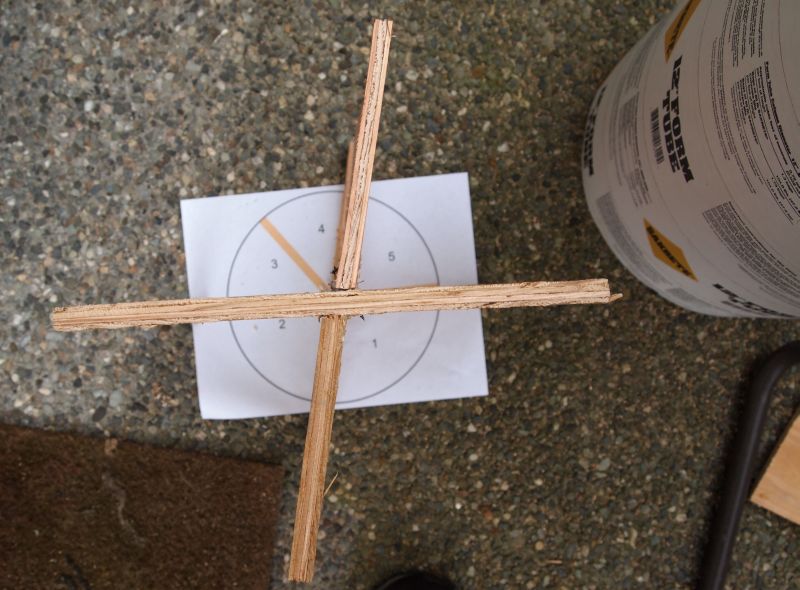
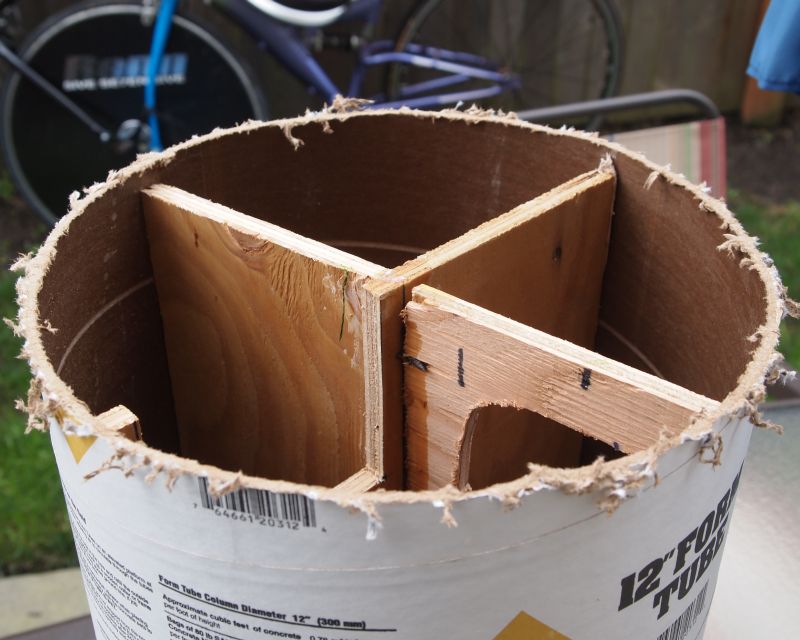

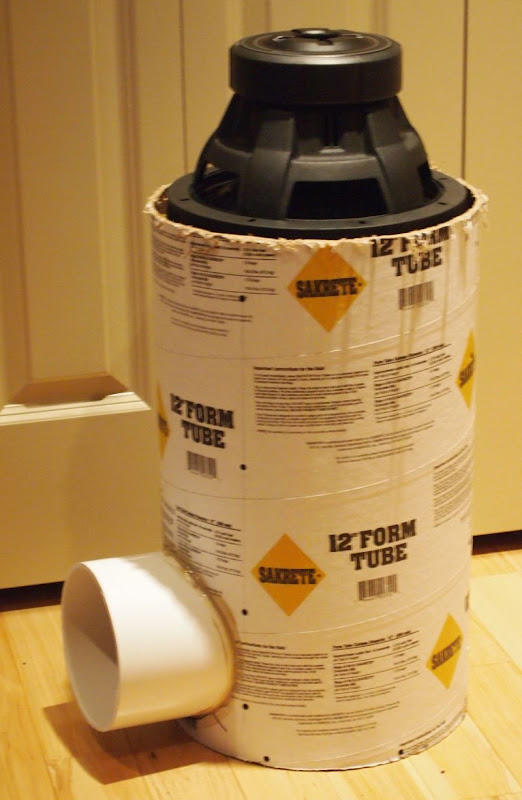
Here's a FLH I built into a sonotube.
It's definitely easier to build a box, but if weight is a concern, sonotube is strong and light. This project worked out fairly well.
If it's not obvious, the pathlength of the horn snakes up and down inside of the sonotube. A little bit like a spiral horn, but more space efficient.
Sure Freddi, plywood is fine.
GM (Government Motors) made some cars with the Bose cannon. The massive 4-1/2" driver was in the corner of the trunk, with the short tube running up through the door and exiting up near the driver, the long tube ran across the trunk and through the other door and exited up near the passenger. The tubes were a rough oval, and made of genuine plastic.
The optimum geometry is to have the two pipe exits one-half of the total pipe length apart, the front pipe one-quarter of the total pipe length. It's based on half-square antenna theory, shaped like an inverted 'U'. Being a loudspeaker it can be folded into any convenient shape (as it was in their boom-box).
As for the cannon vs the tapped horn, I don't know. For portability issues having the two pipe ends half the total length may not be a good form factor. I don't know how to sim this Bose design either. Any AkAbak wizzards?
pics:

^^ note that the woofer is not in the center. You can model this in hornresp. To do so, make a BLH with a vented back chamber. A BLH with a vented back chamber is the same thing, the only difference is that a horn has a duct in front of the woofer that expands. You do not need Akabak.

A great use of isobaric loading. Increased power handling and reduced box size, very important for a tiny sports car like an RX-7.
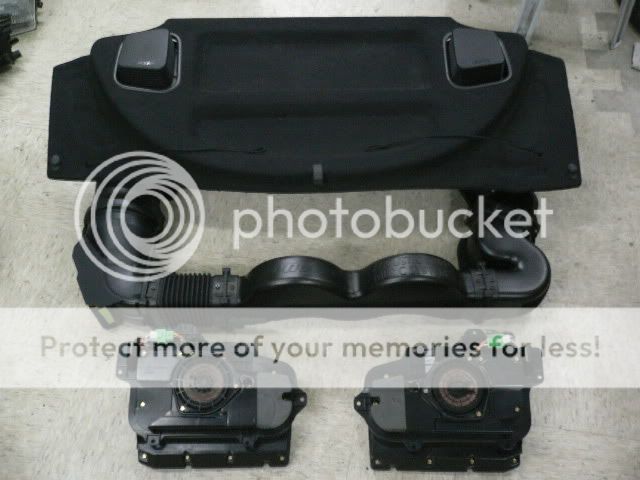
Some thoughts:
1) I could never come up with a wave cannon that had flat response and no flare. IE, flaring the pipe flattens the response, but it also makes it a lot harder to build.
2) The reviews on the car forums are dreadful. A lot of them are basically "this is my RX-7 sub, what can I buy to replace it?"
Congrats - you are now a front-runner in the ugly-*** box contest 🙂
If it's not obvious, the pathlength of the horn snakes up and down inside of the sonotube. A little bit like a spiral horn, but more space efficient.
FWIW, this can be done in a simple rectangular box as well. See The Subwoofer DIY Page v1.1 - Projects : A "Proof of Concept" tapped pipe** - introduction . It's possible to vary the taper by simply changing the angles of the internal panels.
2) The reviews on the car forums are dreadful. A lot of them are basically "this is my RX-7 sub, what can I buy to replace it?"
Not surprising. It's based on a 4.5" driver. In an RX-7.
In car audio world, more efficient use of space trumps more efficient use of a driver. And there's no replacement for displacement.
I do not see the merit in having the pipe exit other than coincident. The drawing I saw of the original canon is a straight pipe with the woofer 1/3 of the way from one end. The phase difference of the ends ensures that only one place left to right in the room will have the ends of the pipe correctly adding in phase at your location.
I wrote a model that assumes that the pipe bends and the exits are next to each other.
If you assume no losses in the pipe, you can configure a coincident exit system for enormous efficiency at one frequency. I call it a bass whistle. I have a drawing board plan to build one and test it. Possibly next spring/summer. If it works, it would be the giant killer of the dB drag circuit.
I wrote a model that assumes that the pipe bends and the exits are next to each other.
If you assume no losses in the pipe, you can configure a coincident exit system for enormous efficiency at one frequency. I call it a bass whistle. I have a drawing board plan to build one and test it. Possibly next spring/summer. If it works, it would be the giant killer of the dB drag circuit.
" I do not see the merit in having the pipe exit other than coincident. "
If you have the ends 1/2 of the total length apart the system will have resonant output at 1/4, 1/2, 3/4, and 1 times the length.
If you have the ends 1/2 of the total length apart the system will have resonant output at 1/4, 1/2, 3/4, and 1 times the length.
" I do not see the merit in having the pipe exit other than coincident. "
If you have the ends 1/2 of the total length apart the system will have resonant output at 1/4, 1/2, 3/4, and 1 times the length.
So, its a comb filter on purpose? Certainly does not sound as if it would be musical. Just a gimmick.
If you make the exits coincident you can create a configuration with an actual flat passband at a very low frequency.
A one note bass whistle?
Not interested.
Bose uses EQ on the straight cannon, less is needed for the folded version.
Have you read the Bose patents?
Not interested.
Bose uses EQ on the straight cannon, less is needed for the folded version.
Have you read the Bose patents?
" I do not see the merit in having the pipe exit other than coincident. "
If you have the ends 1/2 of the total length apart the system will have resonant output at 1/4, 1/2, 3/4, and 1 times the length.
Thanks for the tip DJK!
I've simmed these half a dozen times over the years, and I never came up with anything that looked good.
But you mentioned something I'd never considered, which is that the distance from the ends to the listening position are not equidistant.
When I'd simmed Bass Cannons in hornresp, I'd always blasted past the dialog where it asks you to enter the 'path length difference'. I'd always entered zero.
But it's not as simple as that.
This is actually a GREAT thing! It means that the bass cannon is insanely directional, which could be really handy in a room or in a car. Put the bass where you want it.
Here's a few examples of this:

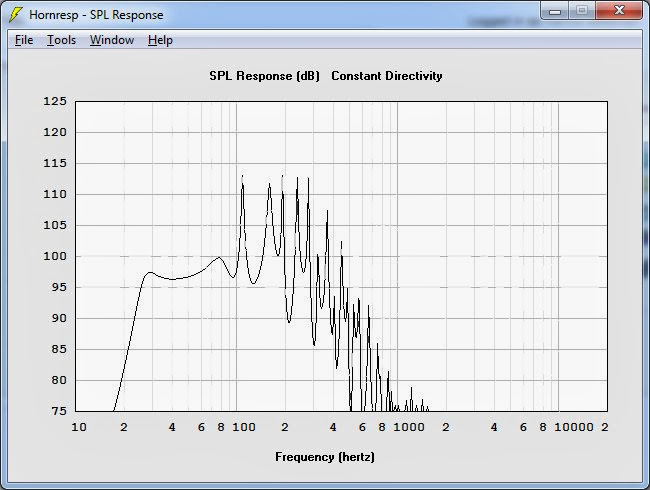
First off, here's a tapped horn with an Alpine 8", the SWR 843D to be specific. This folding is based on the Insubnia sub. I've built a sub similar to this, and it's a great little box.
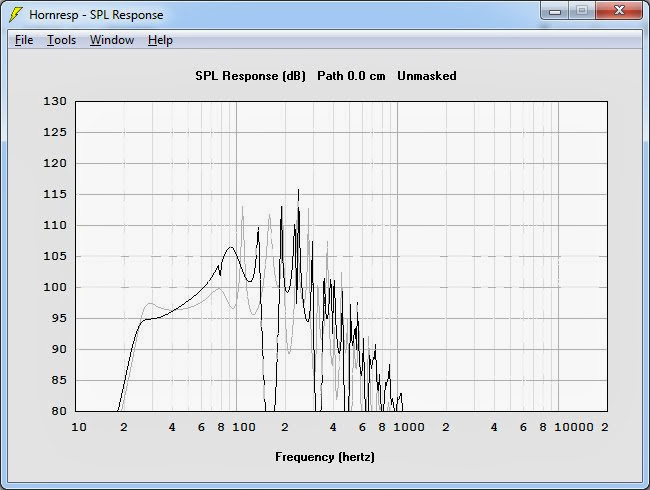
Here's a bass cannon, using basically the same tunings and box size, compared to the tapped horn. We see a couple things:
1) The TH has a little more output at 30hz
2) the bass cannon has a lot more output at 90hz
No big surprises here, Hoffman's Iron Law still rules the day. With comparable volumes, the two boxes have similar output and displacement.
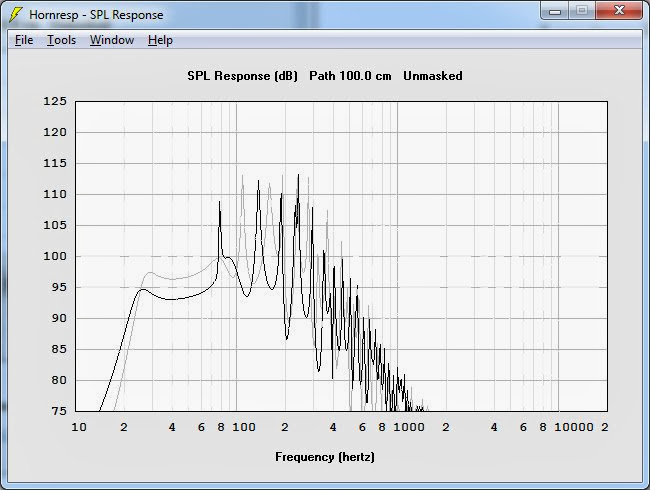
If you change the pathlengths by 100cm, now the tapped horn is significantly louder than the bass cannon. But this isn't necessarily A Good Thing; directional subs sound great. (Just ask anyone with a dipole.)
The easiest way to change the pathlengths is to simply rotate the bass cannon. Probably get a mic out and rotate it until the power response looks good.

Once you maximize the pathlength difference, the output from the far side of the bass cannon has been reduced dramatically. In the real world, I anticipate that the sub wouldn't be as directional as the sims show, as the output from the far side of the bass cannon will be reflected by any walls that are nearby. Having said that, this sub will *definitely* be more directional than a sealed box or tapped horn. The directivity of the sub is due to the pathlength difference, and maximizing that difference maximizes the directivity. In the sims, the output at 60hz drops by ten decibels when you get 90 degrees off axis from the bass cannon. That's like reducing the power from 1000watts to 100 watts!


Here's the hornresp data for the tapped horn and the bass cannon
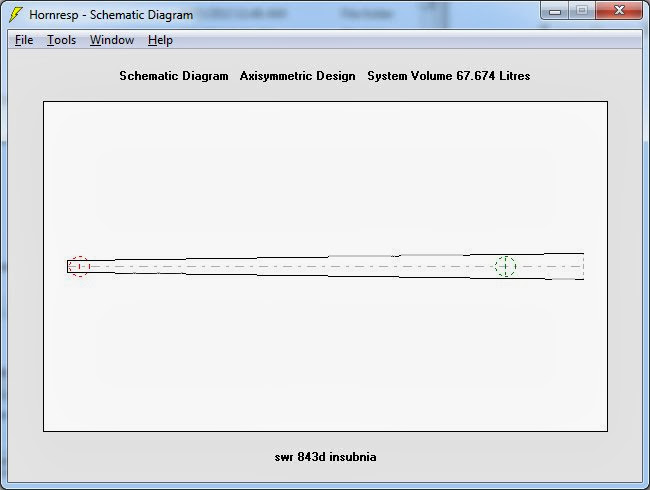

Here's the hornresp layout for the TH and the BC.
Note that the small segment of the bass cannon is created by using the 'ported back chamber' option in Hornresp. This option is under Tools > Chamber > Rear Vented
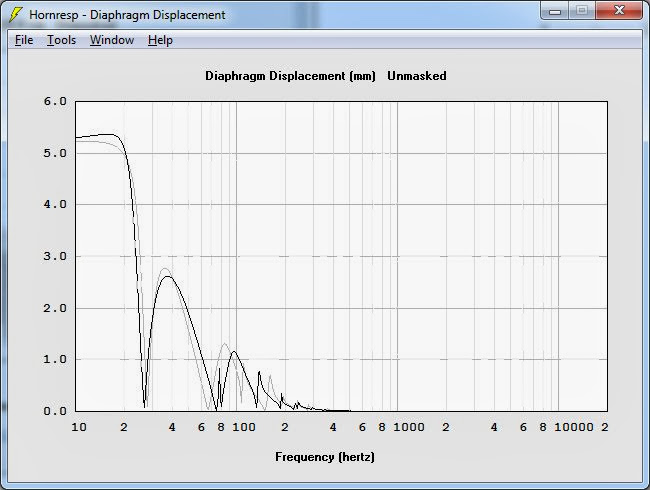
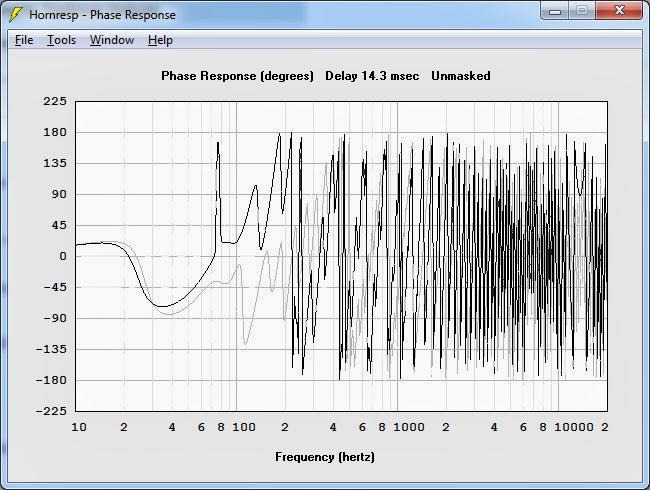
Here's the displacement and the phase response. They're basically identical. The response of the bass cannon is different than the tapped horn due to the pathlength differences, but the displacement, impedance and phase is similar because they're both tuned to the same frequency and their volume is basically the same. (Hoffman's Iron Law.)
Last edited:
I have not read the patent. If you have a link that would be helpful.A one note bass whistle?
Not interested.
Bose uses EQ on the straight cannon, less is needed for the folded version.
Have you read the Bose patents?
I read the marketing blurb and saw a picture and then wrote a simulator for a coincident exit case. I dismissed the straight pipe as Bose made it because every place in a room will have a different freq response.
But with real-world rooms, doesn't every location have varying frequency response? I'm still a fan of the sonotube woofer (mainly because I spent 30 minutes building one [grin]) but an additional problem is that your options to place the effectively two sound sources is more limited than if you build a custom box. On the up side, you don't have to build a custom box ... let the battle continue.
If I have another home built (or can figure out how), I want to consider putting a huge Sonotube (or two) in the attic and then worry about how to duct them into a listening area 🙂
If I have another home built (or can figure out how), I want to consider putting a huge Sonotube (or two) in the attic and then worry about how to duct them into a listening area 🙂
Patrick,In the real world, I anticipate that the sub wouldn't be as directional as the sims show, as the output from the far side of the bass cannon will be reflected by any walls that are nearby. Having said that, this sub will *definitely* be more directional than a sealed box or tapped horn. The directivity of the sub is due to the pathlength difference, and maximizing that difference maximizes the directivity. In the sims, the output at 60hz drops by ten decibels when you get 90 degrees off axis from the bass cannon.
You again are mistaking a dip at one frequency at one off axis angle with directivity.
What you are referring to is an interference pattern.
True directivity is over a wide range of frequencies, not something like this series of dips and peaks, which will average out due to room modes.
Art
Patrick,
You again are mistaking a dip at one frequency at one off axis angle with directivity.
What you are referring to is an interference pattern.
True directivity is over a wide range of frequencies, not something like this series of dips and peaks, which will average out due to room modes.
Art
Moderator, I'm being stalked by Art Welter! 😱
OK, just kidding.
IMHO, we're arguing about terminology here. And that's perfectly acceptable, in engineering it's really important to have a well defined terminology, and I appreciate you calling me on my theories. (or calling me on my BS. Or maybe my theories are BS, it's possible!)
You appear to be saying that interference patterns won't give you 'true directivity.'
If so, then what is 'true directivity? Do we draw a line in the sand and say a device has to have directivity over a full octave to have 'true directivity?'
Here's an anecdote to illustrate the situation I'm in:
A few years back I built a big dipole sub and put a couple of TC Sounds fifteens in it. The sub was extremely simply, it was literally a 8'x8' sheet of plywood. I put it under my bed.
It sounded great.
One problem though - it made the living room unusable when it was running. My bedroom was upstairs, above the living room, and when the sub was running it sounded like someone was stomping on the ceiling.
Nowadays, I live in a tiny apartment in horribly expensive San Diego and I'd really like to find a low frequency solution that can be played above 90dB.
So that's a big part of the reason that I'm on the quest for LFE directivity.
Maybe the directivity of a Bass Cannon isn't perfect, but it IS more directional than a tapped horn, sealed box, or vented box.
An externally hosted image should be here but it was not working when we last tested it.
The Bass Cannon has a series of advantages for apartment dwellers:
1) There's no mistaking a drop in output off axis. This can be used to the advantage of an apartment dweller. For instance, it appears that there is more output generated by the long end, so that end can be directed at the ceiling or at the floor. With room modes, the 10dB drop we see in Hornresp will likely be greatly attenuated. But 10dB is a LOT of attenuation, and I'd be thrilled if I could turn my stereo up even 3 or 6dB.
2) Bass Cannons can be made really lightweight via the use of sonotube. Strapping them to the ceiling with nylon cords is a great way to keep the bass cannon from shaking the entire structure because nylon cord creates a 'lossy' connection to the structure, similar to putting a loudspeaker on spikes.
3) The ability to ceiling mount a subwoofer can save valuable space. Here in California you can spend $82,000 on a parking spot (San Francisco's Most Expensive Parking Spot Sells For $82,000) so reducing the footprint of your subs is a great way to save money. (I wish I was back in Oregon where homes are huge and inexpensive!)
Last edited:
But with real-world rooms, doesn't every location have varying frequency response? I'm still a fan of the sonotube woofer (mainly because I spent 30 minutes building one [grin]) but an additional problem is that your options to place the effectively two sound sources is more limited than if you build a custom box. On the up side, you don't have to build a custom box ... let the battle continue.
If I have another home built (or can figure out how), I want to consider putting a huge Sonotube (or two) in the attic and then worry about how to duct them into a listening area 🙂
My point is that if you place this non-coincident exit gizmo on a large empty parking lot and walk around it in a circle, the freq resp changes every step you take. I would not call it directional in any way. The peaks and dips of the comb filter behavior will change with every step around the circle. This is sort of similar to the modal behavior when you walk around the perimeter of a room and hear the boomy spots in the corners and edges of the room.
If the exits of the gizmo are coincident then the system will be omnidirectional.
The way I model the coincident exits makes the system a bandpass TL.
One of my objections to this system is that the low midrange overtones generated are 10-30 dB above the bass output. This reminds me of the cone breakup artifacts of magnesium mid-woof drivers. I hate the sound of these midwoofs. They are like daggers in the ear. No matter how much you notch filter them they do not sound good.
These kind of systems ring like a bell. You can get similar freq resp and a low Fbox alignment with a passive radiator. They ring like a bell as well.
Stalking, no it seems more like "whack a mole" to me, you plant one bomb that needs defusing, then another, then another.. I don't know why I keep volunteering for damage control, I'm already missing two fingers and half a thumb 😱.Moderator, I'm being stalked by Art Welter! 😱
OK, just kidding.
IMHO, we're arguing about terminology here. And that's perfectly acceptable, in engineering it's really important to have a well defined terminology, and I appreciate you calling me on my theories. (or calling me on my BS. Or maybe my theories are BS, it's possible!)
You appear to be saying that interference patterns won't give you 'true directivity.'
If so, then what is 'true directivity? Do we draw a line in the sand and say a device has to have directivity over a full octave to have 'true directivity?'
The Bass Cannon has a series of advantages for apartment dwellers:
1) There's no mistaking a drop in output off axis. This can be used to the advantage of an apartment dweller. For instance, it appears that there is more output generated by the long end, so that end can be directed at the ceiling or at the floor. With room modes, the 10dB drop we see in Hornresp will likely be greatly attenuated. But 10dB is a LOT of attenuation, and I'd be thrilled if I could turn my stereo up even 3 or 6dB.
1) The drop of 10 dB is at one frequency at one directional point. It won't make the cannon any quieter downstairs when you put it under your bed or up your
Directivity pattern is generally regarded as the -6 dB points over a specified bandwidth, such as: 90 X 90 degrees, 1000 Hz to 16,000 Hz.
That would be four octaves of response fitting in to a specified pattern window.
For a sub to have even pattern control over a useful bandwidth over it's coverage range would be useful, but being louder in one direction at one frequency and louder at another frequency at another direction (as the cannon is) is not useful pattern control, unless you only plan to play it at one frequency.
[Intelligent Donkey mode = ON]
"Ringing a bell?" Hmmm...we could call these subs "Johnny B. Goode" subs. Now, if we can get Chuck Berry to switch to electric bass, we will have done it all.
[Intelligent Donkey mode = OFF]
"Ringing a bell?" Hmmm...we could call these subs "Johnny B. Goode" subs. Now, if we can get Chuck Berry to switch to electric bass, we will have done it all.
[Intelligent Donkey mode = OFF]
- Status
- Not open for further replies.
- Home
- Loudspeakers
- Subwoofers
- Help the Ijit -- Build a "Bose Cannon" knockoff
![TH [shadow] Vs BWC response.gif](/community/data/attachments/353/353232-fd0880cc56ad2dbf2c2de75c5edc2a27.jpg?hash=_QiAzFatLb)
![TH [shadow] Vs BWC peak output.gif](/community/data/attachments/353/353236-cc9349f2a669d098a616861d7217f3be.jpg?hash=zJNJ8qZp0J)
![TH [shadow] Vs BWC peak output 2.gif](/community/data/attachments/353/353238-e1ad8d59c8264e9bfe55b185b0d5e51c.jpg?hash=4a2NWcgmTp)